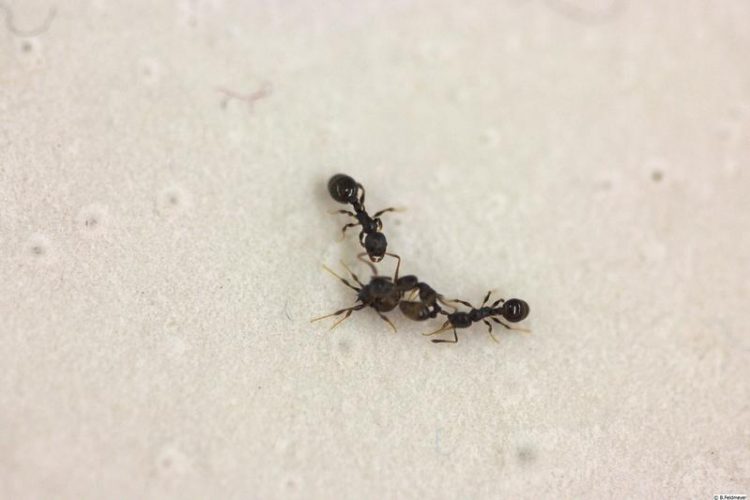Ant raids: It’s all in the genes

The Temnothorax americanus ant in the middle is battling with two ants from the species Temnothorax longispinosus in order to enslave them. Copyright: Barbara Feldmeyer
Barely 3mm long and yet a veritable war machine – the North American ant species Temnothorax americanus should not be underestimated, since it belongs to a group of ants that capture closely related ant species and make them work in their own colonies.
The task of these so-called slaves is to raise their conquerors’ brood and to supply food. In order to acquire slaves, ants such as Temnothorax americanus set out on raids. Researchers from the Senckenberg Biodiversity and Climate Research Center and the University of Mainz study which genes control these raids.
“Our experiments show that the combat strategies of Temnothorax americanus and its relatives, Temnothorax dulocticus and Temnothorax pilagens, are basically very similar. However, the details of the attacks differ from species to species,” explains Dr. Barbara Feldmeyer of the Senckenberg Research Center for Biodiversity and Climate, and she adds, “During the raid the differences in the tuning of individual genes become particularly apparent.”
This, together with other findings, suggests, that in the slave-raiding ants differences in gene expressions, i.e., the reading of the gene sequence and the transcription into proteins, is solely geared toward the raid. Similar patterns were also discovered in the potential slaves, which showed different, genetically based defense patterns.
Figuratively speaking, different gene expression means that that in the genetic material of the three ant species, certain buttons are pressed at different levels of intensity – yet, ultimately, this leads to the same result in all species: a successful raid. The team was surprised by these findings, since for closely related, genetically similar species it was assumed that they would all follow similar genetic paths to achieve a specific goal.
However, this study now shows that genetic evolution among closely related species may well be the result of random selection. “The results suggest that many evolutionary adaptations can be traced back to random mutations. These mutations lead to genetic differences even between closely related species. However, since these species are often subject to similar selective pressure, the result of the adaptive processes, i.e., the behavior, is similar,” explains Professor Susanne Foitzik of the University of Mainz.
Despite their differences, the three slave-holding Temnothorax species appear to share two genes that are important for the raids. “Acyl-CoA Delta (11) Desaturase causes the attackers to emit chemical scents during the raid. These scents mask the attackers, thereby increasing the chances for a successful raid. On the other hand, the gene Trypsin-7 appears to affect the recognition potential, thus enabling – at least in part – the identification of the host colonies required for a raid,” adds Feldmeyer in summary.
Contact
Dr. Barbara Feldmeyer
Senckenberg Biodiversity and Climate Research Centre
Tel. +49 (0)69- 7542 1839
barbara.feldmeyer@senckenberg.de
Sabine Wendler
Press officer
Senckenberg Biodiversity and Climate Research Centre
Tel. +49 (0)69- 7542 1818
pressestelle@senckenberg.de
Publication
Alleman, A., Feldmeyer, B. and Foitzik, S. (2018): Comparative analyses of co-evolving host-parasite associations reveal unique gene expression patterns underlying slavemaker raiding and host defensive phenotypes. Scientific Reports, doi:10.1038/s41598-018-20262-y
Press images may be used at no cost for editorial reporting, provided that the original author’s name is published, as well. The images may only be passed on to third parties in the context of current reporting.
This press release and press images are also available at http://www.senckenberg.de/presse
To study and understand nature with its limitless diversity of living creatures and to preserve and manage it in a sustainable fashion as the basis of life for future generations – this has been the goal of the Senckenberg Gesellschaft für Naturforschung (Senckenberg Nature Research Society) for 200 years. This integrative “geobiodiversity research” and the dissemination of research and science are among Senckenberg’s main tasks. Three nature museums in Frankfurt, Görlitz and Dresden display the diversity of life and the earth’s development over millions of years. The Senckenberg Nature Research Society is a member of the Leibniz Association. The Senckenberg Nature Museum in Frankfurt am Main is supported by the City of Frankfurt am Main as well as numerous other partners. Additional information can be found at http://www.senckenberg.de
Media Contact
All latest news from the category: Life Sciences and Chemistry
Articles and reports from the Life Sciences and chemistry area deal with applied and basic research into modern biology, chemistry and human medicine.
Valuable information can be found on a range of life sciences fields including bacteriology, biochemistry, bionics, bioinformatics, biophysics, biotechnology, genetics, geobotany, human biology, marine biology, microbiology, molecular biology, cellular biology, zoology, bioinorganic chemistry, microchemistry and environmental chemistry.
Newest articles

First-of-its-kind study uses remote sensing to monitor plastic debris in rivers and lakes
Remote sensing creates a cost-effective solution to monitoring plastic pollution. A first-of-its-kind study from researchers at the University of Minnesota Twin Cities shows how remote sensing can help monitor and…

Laser-based artificial neuron mimics nerve cell functions at lightning speed
With a processing speed a billion times faster than nature, chip-based laser neuron could help advance AI tasks such as pattern recognition and sequence prediction. Researchers have developed a laser-based…

Optimising the processing of plastic waste
Just one look in the yellow bin reveals a colourful jumble of different types of plastic. However, the purer and more uniform plastic waste is, the easier it is to…



